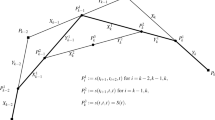Abstract
In this paper, we derive conditions for best uniform approximation by fixed knots polynomial splines with weighting functions. The theory of Chebyshev approximation for fixed knots polynomial functions is very elegant and complete. Necessary and sufficient optimality conditions have been developed leading to efficient algorithms for constructing optimal spline approximations. The optimality conditions are based on the notion of alternance (maximal deviation points with alternating deviation signs). In this paper, we extend these results to the case when the model function is a product of fixed knots polynomial splines (whose parameters are subject to optimization) and other functions (whose parameters are predefined). This problem is nonsmooth, and therefore, we make use of convex and nonsmooth analysis to solve it.


Similar content being viewed by others
References
Nürnberger, G.: Approximation by Spline Functions. Springer, Berlin (1989)
Nürnberger, G., Schumaker, L., Sommer, M., Strauss, H.: Approximation by generalized splines. J. Math. Anal. Appl. 108, 466–494 (1985)
Rice, J.: Characterization of Chebyshev approximation by splines. SIAM J. Numer. Anal. 4(4), 557–567 (1967)
Schumaker, L.: Uniform approximation by Chebyshev spline functions. II: free knots. SIAM J. Numer. Anal. 5, 647–656 (1968)
Sukhorukova, N., Ugon, J.: Characterization theorem for best linear spline approximation with free knots. Dyn. Contin. Discrete Impuls. Syst. 17(5), 687–708 (2010)
Sukhorukova, N., Ugon, J.: Characterization theorem for best polynomial spline approximation with free knots. Trans. Am. Math. Soc. arXiv:1412.2323 (2016)
Gavurin, M., Malozemov, V.: Extremum problems with linear constraints. Leningrad University Press, Leningrad (1984)
Vasil’ev, A.A., Malozemov, V.N., Pevnyi, A.B.: Interpolation and approximation by spline functions of arbitrary defect. Vestn. Leningr. Univ. [Mat.] 12, 262–271 (1980)
Rockafellar, R.: Convex Analysis. Princeton University Press, Princeton (1970)
Demyanov, V., Rubinov, A.: Constructive Nonsmooth Analysis. Peter Lang, Frankfurt am Main (1995)
Demyanov, V., Rubinov, A. (eds.): Quasidifferentiability and Related Topics, Nonconvex Optimization and Its Applications, vol. 43. Kluwer Academic, London (2000)
Nürnberger, G.: Bivariate segment approximation and free knot splines: research problems 96–4. Constr. Approx. 12(4), 555–558 (1996)
Zamir, Z.R., Sukhorukova, N., Amiel, H., Ugon, A., Philippe, C.: Optimization-based features extraction for k-complex detection. ANZIAM 55, C384–C398 (2014)
Zamir, Z.R., Sukhorukova, N., Amiel, H., Ugon, A., Philippe, C.: Convex optimisation-based methods for k-complex detection. Appl. Math. Comput. 268, 947–956 (2015)
Zamir, Z.R., Sukhorukova, N.: Linear least squares problems involving fixed knots polynomial splines and their singularity study. arXiv:1503.01176 (2015)
Sukhorukova, N.: Uniform approximation by the highest defect continuous polynomial splines: necessary and sufficient optimality conditions and their generalisations. J. Optim. Theory Appl. 147(2), 378–394 (2010)
Demyanov, V., Malozemov, V.: Introduction to Minimax. Wiley, New York (1974)
Stiefel, E.: Note on jordan elimination, linear programming and tchebycheff approximation. Numer. Math. 2(1), 1–17 (1960). doi:10.1007/BF01386203
Carathéodory, C.: Uber den variabilitatsbereich der fourierschen konstanten von positiven harmonischen funktionen. Rend. Circ. Mat. Palermo (2) Suppl. 32(1), 193–217 (1911). doi:10.1007/BF03014795
Mirrlees, J.A.: Optimal tax theory: a synthesis. J. Public Econ. 6(4), 327–358 (1976)
Tuomala, M.: Optimal Income Tax and Redistribution. Oxford University Press, Oxford (1990)
Sukhorukova, N.: A generalization of the remez algorithm to a class of linear spline approximation problems with constraints on spline parameters. Optim. Methods Softw. 23(5), 793–810 (2008)
Remez, E.Y.: General Computation Methods of Chebyshev Approximation. The Problems with Linear Real Parameters. Publishing House of the Academy of Science of the Ukrainian SSR, Kiev (1957). English translation, AEC-TR-4491, United States Atomic Energy Commission
Author information
Authors and Affiliations
Corresponding author
Rights and permissions
About this article
Cite this article
Sukhorukova, N., Ugon, J. Chebyshev Approximation by Linear Combinations of Fixed Knot Polynomial Splines with Weighting Functions. J Optim Theory Appl 171, 536–549 (2016). https://doi.org/10.1007/s10957-016-0887-0
Received:
Accepted:
Published:
Issue Date:
DOI: https://doi.org/10.1007/s10957-016-0887-0




